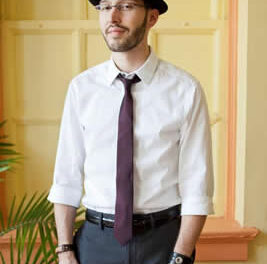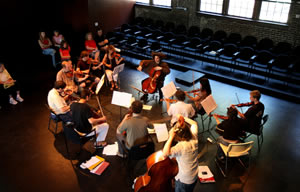The Carolina Ballet has become widely popular, and rightly so, for its lavishly staged story ballets, but dance lovers who forgo the company’s programs of shorter works do themselves a disservice. Stripped of the distractions of scenery and fancy costumes and unimpeded by plot-forwarding stage business, the pieces in the Ballet Plus programs include some of the best dancing I’ve seen by the troupe.
Having become accustomed to large crowds for the story ballets, I was taken aback by the lesser attendance for these works. The tiny audience on February 16, the Sunday of the ice storm, I could understand, but Fletcher Opera Theater was again far from full on February 22, the Saturday evening of the second week. Fortunately, viewers that missed these dances during the first two weeks will have another opportunity, as the two programs of Ballet Plus will be performed again, on alternating nights, February 27-March 2. (See our calendars for details, a link to the company, and information about a March 8 performance in Wilmington.)
Program One was all danced to solo piano, played by Karl Mosaski (the opening and closing works) and Nancy Whelan. The program opened with Franz Liszt’s “Tarantella” (S.162/3), choreographed by company ballet master Marin Boieru. Based on the street dances of southern Italy, it is danced cheerfully by Margaret Severin-Hansen and Pablo Javier Perez. These two are a good match in size and style. There are no fussy, mincing steps here – Boieru has given them gay, open movements, and both dancers have a natural buoyancy and good humor that serves the piece well.
The light “Tarantella” was an excellent foil for the following piece, “La Maja,” choreographed by Robert Weiss to Enrique Granados’ Allegro di Concierto and danced by Melissa Podcasy and Timour Bourtasenkov, who nearly ignited the stage. This is the sexiest ballet I’ve ever seen. Podcasy is in her element here, emanating a dark erotic power in her gold net bolero “jacket” and black tights. Weiss’s bold-hearted choreography forms one powerful shape after another, in a series of movements that consume the stage and condense its air into the explosive breath of passion. Bourtasenkov and Podcasy throw themselves at one another with the kind of daring and abandon that can only come with artistic self-confidence and complete control.
Even a great piece might have paled after that blazing performance, but sadly the next work on the program was the weakest. “Les Esprits d’Eau,” choreographed by Donald Mahler to Maurice Ravel’s music (taken from “Le Tombeau de Couperin,” “Gaspard de la nuit,” and the Sonatine), was a nice enough thing, but it just didn’t quite come alive. Ross Kolman’s mood-setting lighting (Kolman is a genius with the lighting design) and graceful flowing costumes just couldn’t make up for undifferentiated prettiness of the choreography or for the lack of sizzle in the dancing. Primary dancers Lillian Vigo and Christopher Rudd finally worked up some chemistry between them in the third movement, and Heather Eberhardt and Maximilien Baud did some good work, but all in all it didn’t come up to the Carolina Ballet standard.
“Visions,” the final piece on the first program, had generated a great deal of curiosity beforehand, as it is choreographed by the company’s lead male dancer, Timour Bourtasenkov to music written by company pianist Karl Moraski. While it was just a tiny bit rough around the edges, and maybe is a shade too literal, this is a very interesting work. Moraski’s music is emotive and fresh, and the dance is full of Timour-like movements for the men – great whirls and leaps and bold turns. Generally I am leery of art about art, but Bourtasenkov and the dancers, especially Mikhail Nikitine as the artist, and Margot Martin as the Lady in Black, have found a way to express the difficult relationship of an artist with his creations without overdoing it. I look forward to seeing more pieces choreographed by Bourtasenkov, even though it may mean foregoing the tremendous happiness of seeing him on the stage.
For Program Two the music is not solo piano but the rich warm sounds of the Ciompi Quartet, with the whom the Carolina Ballet has collaborated since the Ballet’s first season here. Equally at home with music from the 19th, the 20th and the 21st centuries, the Quartet is excellent, as always, and it is such a pleasure to hear them in the A.J. Fletcher Opera Theater, where the acoustics are so good.
In fact, all the pleasure to be derived from the first piece, “Movement Poem I,” by Anton von Webern, came from the music (Langsamer Satz, 1905), rather than the dance. Choreographed by Christopher Wheeldon, this piece was just wasn’t very good. It didn’t make dynamic use of the stage, and the movements were boring and predictable. It also looked under-rehearsed. Heather Eberhardt drew some lovely lines with her body, but even she looked stiff and tense most of the time.
However, once we got that mess out of the way, the rest of the evening was glorious. “Inscapes,” founded on Peter Sculthorpe’s String Quartet No. 8 and choreographed by Damian Woetzel, was beautiful. Some of the images brought tears to my eyes. It is full of springy, elastic sounds and movements – pull, resist, come together – alternating with plucked strings and sharp little steps and quick turns – and the most moving lifts and carrys. Lillian Vigo and Alain Molina are especially wonderful together. She clings to him in a miraculous way as he moves across the stage. Even with his arms extended, his strength holds and guards her delicacy. There is one moment when her slender arms cross over his broad back in a wing-like caress that is so poignant.
Podcasy and Bourtasenkov are stunning in this piece. Their pas de deux begins in the dark, with her folded into a small shape on his shoulder. The lights come up, but behind them, and they are backlit for much of the dance. Somehow seeing them moving in silhouette like this was so powerful and pure, like the great Matisse cut-out forms. When the lighting changed to illumine their faces and restore color and depth to their forms, the gush of feeling elicited was undiluted joy.
As fine as she was in “Inscapes,” Podcasy was just getting warmed up for “Game Over.” This choreography by Tyler Walters, to music from String Quartet No. 2 (“Musée Mécanique”) (2002) by Nathaniel Stookey (Composer in Residence with the North Carolina Symphony), draws on imagery from team sports, pinball machines and sexual games. The music itself is at once playful and challenging, and a little bit flirty. High points include Pablo Javier Perez flying across the stage in a long series of grand jetés, but it is Podcasy who makes the piece. She is just magnificent here, as good or better than I’ve ever seen her. There are seven other dancers on the stage at times, but when she is there, she’s the one you can’t take your eyes from. In one great sequence the four men raise her overhead and then pass her backward over their shoulders to the next man behind, all while she is twisting and extending and posturing – dancing horizontally in mid-air. Throughout the piece she hurls herself or is thrown into the arms of one of the men, who transforms all that forward-rushing energy into a bravura spin or lift. There is nothing delicate here. Whatever game is being played, Podcasy is going flat out for the gold.
A happy surprise in the program was the addition of Weiss’s ballet set to Beethoven’s “Gro?e Fuge.” He’s started with the way the music plays off itself and visualized a dance like an M.C. Escher drawing come to life, where black and white change places and your perception of the pattern flips back and forth. The stage is as crisp and as busy as an Escher, with a dozen dancers in addition to the principals, Lillian Vigo, Timour Bourtasenkov, and Mikhail Nikitine. Vigo is the pivot for the imagery: Dancing with Bourtasenkov, the white prince, she is all in white. Nikitine, the black prince, pulls her away and she spins off-stage – only to reappear as the black princess. The process reverses several times, while the ensemble weaves patterns around them. Vigo is a very beautiful dancer, with a natural elegance and delicacy well suited to the swan-like movements Weiss gives her. She was lovely with Bourtasenkov, who seemed to temper his intensity and become more pliable with her than he is with Podcasy, but the chemistry between her and Nikitine, himself a vigorous force, makes them look like the company’s rising star pair.
That idea was reinforced in the evening’s final work, Antonin Dvorak’s “The American” (movements 1, 2 and 4 of String Quartet No. 12, in F, Op. 96). After the dull “Movement Poem I,” choreographer Christopher Wheeldon completely redeems himself with this one. It is boisterous, bold, even a little brash, full of images of folk-dances, square dances, line dances, Broadway dances, with some skyscrapers thrown in for good measure. The dancer pairs all appeared to have been having a great time, and the Ciompi Quartet’s playing soared out above the percussion of six pairs of toe shoes. Margaret Severin-Hansen and Pablo Javier Perez, who we had seen so well matched in “Inscapes” and “Tarantella,” were completely delightful. But Lillian Vigo and Mikhail Nikitine, fresh from their considerable exertions in black and white, were utterly ravishing. Their every move exhilarated, and when the curtain went down he was holding her aloft like a lantern in her yellow dress, lighting the way to an ever more glorious future.












